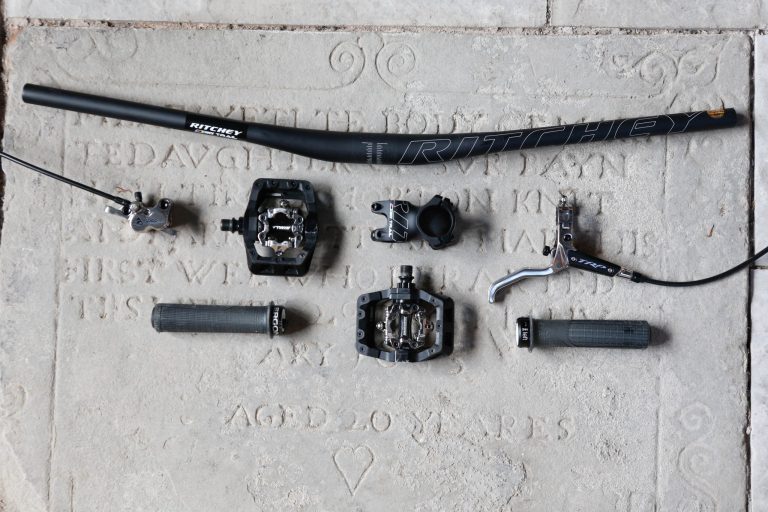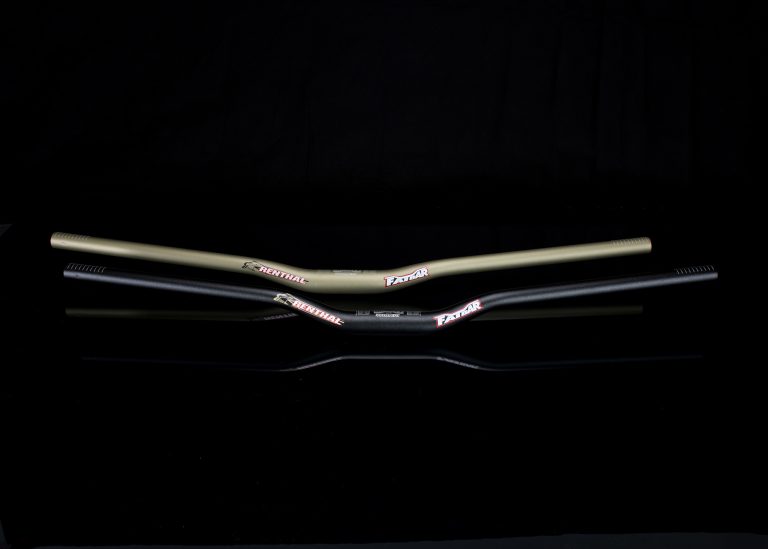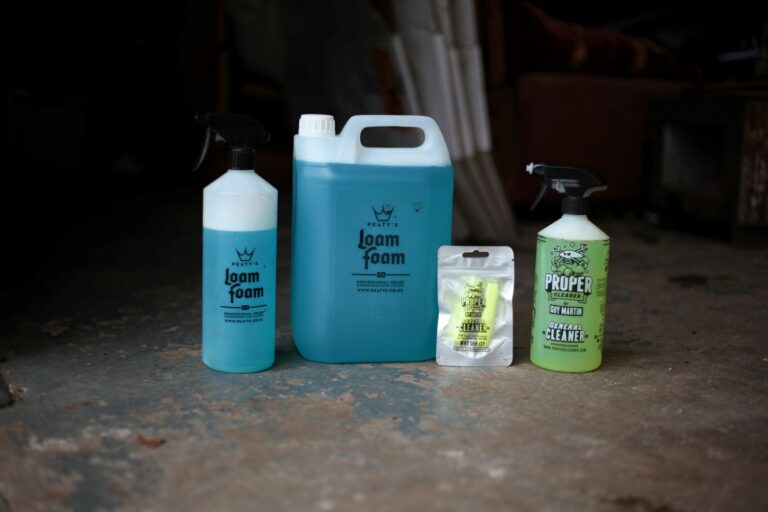A COMPARISON BETWEEN
GEE ATHERTON’S PRO BIKE
AND THE PRODUCTION MODEL
Words Steve Jones Photos Victor Lucas
The Commencal Supreme DH bike ridden by Gee,
Dan and Rachel Atherton is the most successful
race bike of the 2008 downhill season. Is it?
Well of course it is. With prototype suspension,
geometry, and given all the care and attention
from a pair of wily old Irishmen (the Atherton
mechanics Steve Bell and Skinny) this is the bike
loads of people would like to get their hands on.
The fact that both the family and the company
have got their act together working to get good
equipment is one of the many factors that have
enabled the Athertons to considerably step up
their game this season. But how different is it
really from the bike you can buy?
From the second you hit any kind of screwed up
terrain you’ll know why. The suspension is very
good – as it would be from two units hand built from
the dust caps upwards. But it would be unfair to
give Fox shock absorbers all the credit because the
guys at Commencal in Andorra, Nicolas Menard in
particular, have done their homework on the frame
very well.
Commencal have really worked as a team on this
bike with the Athertons. Last season’s bike had
less travel than this years offering (seven inches)
and Gee pointed out how much work he had to do
compared with this eight inch version of something
that was already very good. It’s pretty clear that he
has been hitting the tops of stuff this season rather
than falling into the holes, which culminated in a
superb World Championship victory and a third in
the World Cup series.
In terms of geometry it’s really quite simple.
Although Commencal engineers were eager to point
out that average riders would not be able to ride
this bike because of its extreme angles, the reality
of the matter is that the geometry is really not that
far off many other of the current great bikes that
are out there. More than that we have found out
that the production bikes that will be available by
the time you read this can be set up exactly like
Gee’s. The vitals on Gee’s Schladming bike then
– wheelbase/head angle/chainstay/bottom bracket of
1195mm/63º/450mm/370mm is roughly alongside
other production eight inch bikes such as the Yeti,
Trek and Orange or the factory Iron Horse and
Cannondale.
These lines alone give a bike its stability, but what
the Andorran company have done this season is to
lower the weight in the centre of the bike, simplify
the frame shaping and introduce a modified linkage.
The second key ingredient in this bike, Commencal’s
well known ‘contact system’, is now many years into
its development. Together with the pivot location
the connecting rod and rocker link are largely
responsible for the nature of the rear suspension.
The new Fox damper plays a significant part also.
Naturally. The Supreme’s suspension is a lot firmer
towards the end of its travel than at the beginning.
This progressivity allows good traction at the
beginning of the stroke yet gets quite firm near the end so avoiding having to bottom out. Pretty simple really.

GEE ATHERTON’S WORLD CUP BIKE
Of course the suspension on pro rider’s
bikes supported by Fox is going to be
significantly different to production
equipment. Fortunately the Commencal
was sprung pretty much how I would run
the bike anyway and I hit the absolutely
stinking Schladming hill without making
any adjustment. It was a stunning day of
mud riding. Interesting to discover later
that that Gee leaves all the suspension
adjustments to the Fox technicians.
In the great search for grip this bike is up
there ahead of the party. Part suspension
design, plus a significant amount as
a result of hand built damping, Gee’s
bike is a lesson in keeping the tyres
grounded. The first sector of the travel,
up to about thirty percent front and rear,
is nothing short of incredible. It uses
just the right amount, maintaining good
ride geometry. Compared to say a V10,
which also has a very soft first sector
it’s similar but with less movement on
the shock and chassis. It’s very easy to
read (or feel) where the bike is in this
respect. Obviously the unique damping
plays a part in this and the nickel coated
fork stanchions and damper rod aid
movement especially in the first part
of the travel (there is a fantastic feel to
this fork) and no, you cannot buy them.
But Bill Becker, the man responsible for
designing these forks, points out that
Fox will be selling a limited run of forks
with the firmer compression tune. “The
compression valving and Ti Spring rate
(on the Limited Edition 40 fork) is the
same as Gee’s fork. The only thing that
is not the same in the Limited Edition 40
Fork will not have the EN–plated Upper
tubes and damper shafts. The EN–plating
is not durable enough to put into a FOX
Production Product.”

On the hill you almost go looking to
put the bike into some bother, but the
suspension makes it very difficult to
fault the bike. My only doubt was that
Gee had his compression too hard as I
was feeling the bigger hits through my
feet and hands. I questioned him on this
and he pointed out that the decision
to go for a bike that maintained its
geometry was more important than a
bike that was diving at the front and
using too much rear. This particular
Commencal definitely uses its available
travel really well, as good as any bike
I’ve ever used. When descending through
the Schladming waves of whoops it kept
its shape allowing the rider to maintain
a central position. I’d have gone for
something a bit more forgiving past fifty
percent travel, the progression seems
pretty fierce but then the owner of this
bike has a f–king way higher ground
speed than the guy who’s borrowed it for
the day. Atherton has to deal with far
higher forces. This means taking the hits
a bit more. Strong lad though, so he’ll
cope. When it comes to looking for grip it
was all those percentages ahead that you
would expect from this bike.
Out the back it’s pretty much more
of the same and yet this new damper
is a big improvement on the old DHX.
Flowing four times more oil according to
Mark Fitzsimons, head of the Fox race
programme, it’s a delicious marshmallow
like feel over the small to medium ground
textures. Small impacts are gripped
on leech like, it certainly has moved on
significantly for Fox this year. Like the
front however, because of the severity of
Atherton’s compression past fifty percent,
you do feel the larger braking bumps and
the bigger choppier ground on this bike
as the bike maintains its great geometry.
The contact system obviously plays a part
in this feeling of sharp progression too,
but the general feel is a bike moving down
the mountainside particularly rapidly and
quietly. All in all then some very inspiring
damping qualities.

COMPARISONS
“Average riders wont be able to ride this
bike,” commented Nicolas Menard, the
chief engineer of Commencal, and whilst
I didn’t take his words literally I did
think he was hinting of a huge void in the
geometries between this and production.
As mentioned earlier the figures for
Gee’s bike are pretty much in and around
those being pushed out on a number of
Bike test: Commencal Supreme DH
production bikes, so it’s no big deal
really. For instance the bike Greg
Minnaar has just won the series on is
entirely production and it scores a fair
amount of success all over the world.
I wondered why some companies have
this approach?
Comparisons then. Incredibly close
to Peaty’s old Orange. OK, OK! Sorry.
Hey I’ll keep comparison between pro
and production because essentially
you can buy this frame as much as
Commencal might hint otherwise. Even
though both Gee’s bike and production
have adjustable geometry the bike on
test here, the one he raced to win the
World Championship and third in the
World Cup series, is just so close to the
production bike. Compare those figures
we mentioned earlier on wheelbase/
head angle/chainstay/bottom bracket
on production. On this bike (as
set up for the test on the national
championship track and Schladming)
these figures are all achievable on the
L/XL production version. And with
the different headset inserts the only
real unachievable difference is the
chainstay on Gee’s bike which maxes
out at 464mm (to the nearest mil the
same as another production bike of
a few years ago. Ha!) and the super
bonkers 61º head angle. Gee says he
rarely uses the bike on full extension
anyway. The bike we rode was what
Dan and Gee mostly use.
GEE’S BIKE (measured) PRODUCTION BIKE (L/XL)
H/T angle 63° (61º/63° with sleeves) 63º/65º
BB height 360mm 360mm
Chainstay 449 min – 464 max 440–455
Wheelbase 1195mm 1184–1200
Nicolas Menard explains a bit more
about the adjustability. “The adjustable
head angles work with different inner
sleeves. You have a silver one which
gives a 0° angle difference (the inner
axle is aligned with the outer axle).
Then you can switch to the +/– 1°, here
the inner axle is not aligned with the
outer diameter axle and makes a 0°
difference. You can see on the sleeves
kind of cut out at the bottom of it. To
change from –1° to +1°, you need to
rotate the inner sleeve and align this
little cut out with the frame centreline.
We also have in aftermarket a+/– 0.5°
sleeve.”
“In the end, the production bike is not
that different and you can find the
same set up as the regular Atherton
geometry (which is the one they use
the most: shorter back end and not
the slackest H/T angle)…the position
is really close, but there are just some
details that makes the difference.”

HOW DOES THE PRODUCTION
SUPREME DH COMPARE?
Fortunately then it’s possible to make
direct comparisons of Gee’s bike to the
production because of similar adjustable
geometry. Well I guess we would do
anyway. Unfortunately we were sent
the Supreme DH with the Marzocchi
888RCV and not the CG replica with
Marzocchi RC WC. To a certain extent
the RCV fork let the bike down. We have
since checked to see whether this was a
rogue fork or whether this fork has an
issue in general. We will let you know
in issue 82 (email [email protected]
for more info). Considering that the coil
version of Marzocchi’s downhill fork
is a better option than the air fitted to
the CG Replica riders should seriously
consider the frame with the coil fork or
build with the new RockShox BoXXer.
Whatever you choose, because it is such
a good frame it warrants good money
being spent on a reasonably light build
as the frame isn’t one of the lightest
available, and even Gee’s bike comes it
at over 41lbs. Still a lot lighter than the
standard black Supreme DH that loads
the scales at over 47lb. Surely those
days have long gone?
GEE ATHERTON’S PRACTICE BIKE
Backing up his race bike the Atherton’s
run another bike with standard (yet
modified) Fox units, these being the 40
without nickel stanchions and a DHX
tweaked by the Fox racing team. If I was
to describe the 40 on this bike it has all
the characteristics of a Fox Float 32 or
36, the best 140/160mm forks available.
Smooth with good reaction time and
considerably ‘looser’ than a production
version 40. What I mean here is that it
seems to move quicker to ground changes
yet retains good feel. Not as uptight as a
production fork in other words. Basically
the valving has been re–worked and
the bushings are the best possible fit.
There were definitely differences in feel
of the new rear damper to the old; Gee’s
comments that he had to move last years
bike around more might simply because
it was a more moveable bike but the
damping plays a part.

CONCLUSION
Taking into account that Gee Atherton’s
bike is pretty close to production I’d say
normal riders would be able to ride the
Commencal Supreme DH. Apart from the
whole idea of actually making a different
bike for non–pro riders seems a bit
twisted, fortunately the one–off Atherton
bike, apart from the 9mm out back and
degree up front which Gee rarely uses
anyway, appears to be a slight myth. And
anyway, whoever has heard of riders
complaining that a bike’s too stable?
Steering is based on a combination of
interrelated lines of geometry – the fact
that a couple of other companies have
steepened the head angle on production
bikes seems a bit…well I simply don’t get
it. The bottom line is that this bike of Gee’s
has a good balance point, the same that
can be achieved on production.
In fact this bike is one of the best downhill
bikes currently available. What makes it so
impressive is that it’s very simple and the
geometry, even though you can choose to
pull it in or stick it out, has a narrow range
that will suit most conditions.
In terms of production bikes it loses
points on weight, there are lighter bikes
than this for the same money (and how
come the frame is £300 more than
last year?), and finish. I think Cedric
should use his French flair to inspire
something more along the lines of
what Lapierre are pushing out of their
factory and smooth some of the rough
edges. It’s good but there are companies
now putting more effort into cosmetics
these days. The bottom line however is
that this bike has better geometry than
some of the lookers. Gee’s comments
that it has been “the best race bike this
season” are fully justified. There will
be a lot of riders on these bikes next
year. But it’s a bit more than that again.
With companies like Trek investing in
engineers to tune the shock to match
the suspension design and with Intense
now selling with Cane Creek some
manufacturers are stepping it up.
The Contact System is one of the best
designs available, I’m wondering if when
the new Fox shock becomes available,
like fitted to Gee’s, this could be the
bike that has it all. But then it’s going to come in at one hefty price.
Gee Atherton’s Commencal Supreme DH







